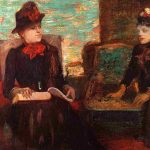Károly Ferenczy, a Hungarian painter and key figure in the development of Hungarian modernism, was born on February 8, 1862, in Vienna, Austria. Ferenczy’s artistic journey unfolded during a period of profound cultural and artistic transformations in Europe, and he played a central role in shaping the trajectory of Hungarian art in the late 19th and early 20th centuries.
Ferenczy’s early artistic education began in Budapest, Hungary, where he studied at the Academy of Fine Arts under the tutelage of Bertalan Székely and Gyula Benczúr. During this period, Hungary was undergoing a cultural renaissance, and Ferenczy became part of a generation of artists eager to explore new artistic ideas and break away from academic conventions.
In 1889, Ferenczy traveled to Munich, Germany, where he encountered the innovative ideas of the Barbizon School and Impressionism. These encounters had a profound impact on his artistic vision, inspiring him to explore plein air painting and the effects of light on the landscape. His exposure to the works of the French Impressionists, particularly Édouard Manet and Camille Pissarro, influenced his move towards a more liberated and expressive style.
Ferenczy’s pivotal moment came in 1896 when he and a group of like-minded artists formed the Nagybánya artists’ colony in Transylvania (now in Romania). This colony, also known as the “Hungarian Barbizon,” became a crucible for the development of modern Hungarian art. The artists embraced a plein air approach, capturing the local landscapes and rural life with a fresh, naturalistic perspective.
The Nagybánya colony, led by Ferenczy, sought to blend the principles of Impressionism with a commitment to national identity and a deep appreciation for Hungarian culture. Ferenczy’s paintings from this period, such as “Spring in the Mountains” (1897) and “Harvesting” (1904), exemplified his dedication to capturing the essence of Hungarian rural life while embracing contemporary artistic trends.
Ferenczy’s commitment to fostering a distinctive Hungarian art continued when he became a professor at the Royal School of Applied Arts in Budapest in 1896. His role as an educator was instrumental in shaping the next generation of Hungarian artists, emphasizing the importance of individual expression and a connection to national identity.
In the early 20th century, Ferenczy’s style evolved towards a more symbolist and decorative approach. His fascination with mythological themes and allegory became evident in works such as “Leda” (1902) and “Apollo and Marsyas” (1904). These paintings showcased his interest in classical subjects while incorporating a personal and modern sensibility.
Ferenczy’s involvement in the Wiener Werkstätte, a Viennese workshop dedicated to the integration of the fine and applied arts, further reflected his commitment to the unity of art and craft. His decorative works, including tapestries and stained glass, demonstrated his versatility as an artist and his belief in the synthesis of artistic disciplines.
The artist’s later career was marked by international recognition, with his works exhibited in major European cities. Ferenczy’s participation in the Venice Biennale in 1910 solidified his status as a leading figure in the European art scene. His paintings, characterized by a harmonious blend of form and color, resonated with audiences beyond Hungary’s borders.
Tragically, Károly Ferenczy’s life and prolific career were cut short by illness. He succumbed to pneumonia on March 18, 1917, at the age of 55. Despite his relatively brief life, Ferenczy’s impact on Hungarian art was profound. His legacy lived on through the Ferenczy Museum in Szentendre, Hungary, established in his honor, and his contributions to the development of Hungarian modernism continued to inspire subsequent generations of artists.
Károly Ferenczy’s embrace of Impressionism, commitment to national identity, and exploration of decorative arts left an enduring mark on the trajectory of Hungarian art. His legacy as a painter, educator, and advocate for the synthesis of art and craft contributed to the rich tapestry of European modernism in the early 20th century.






